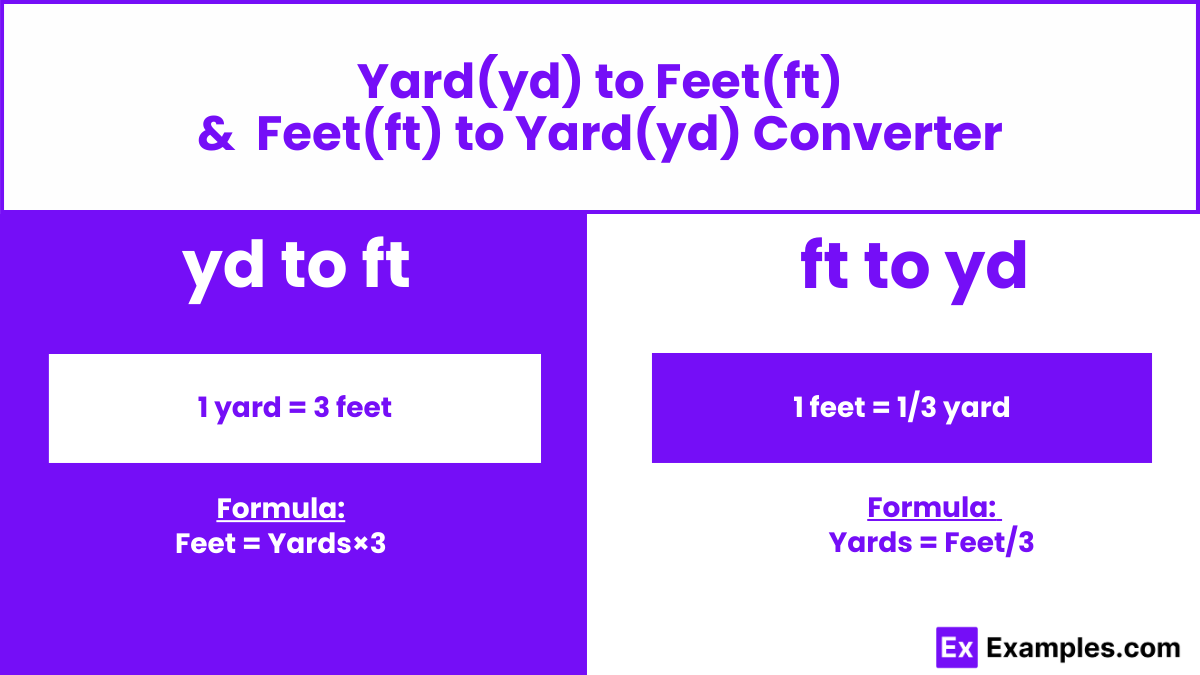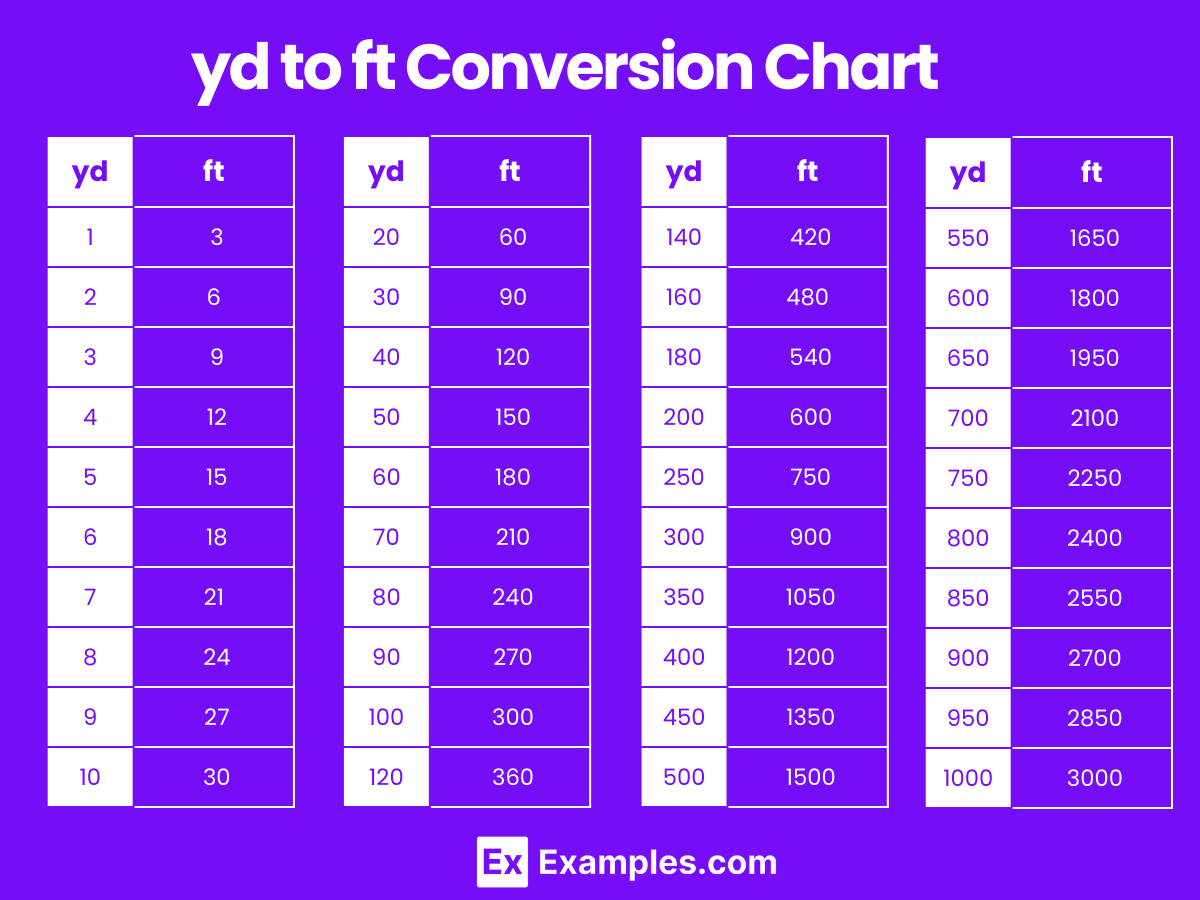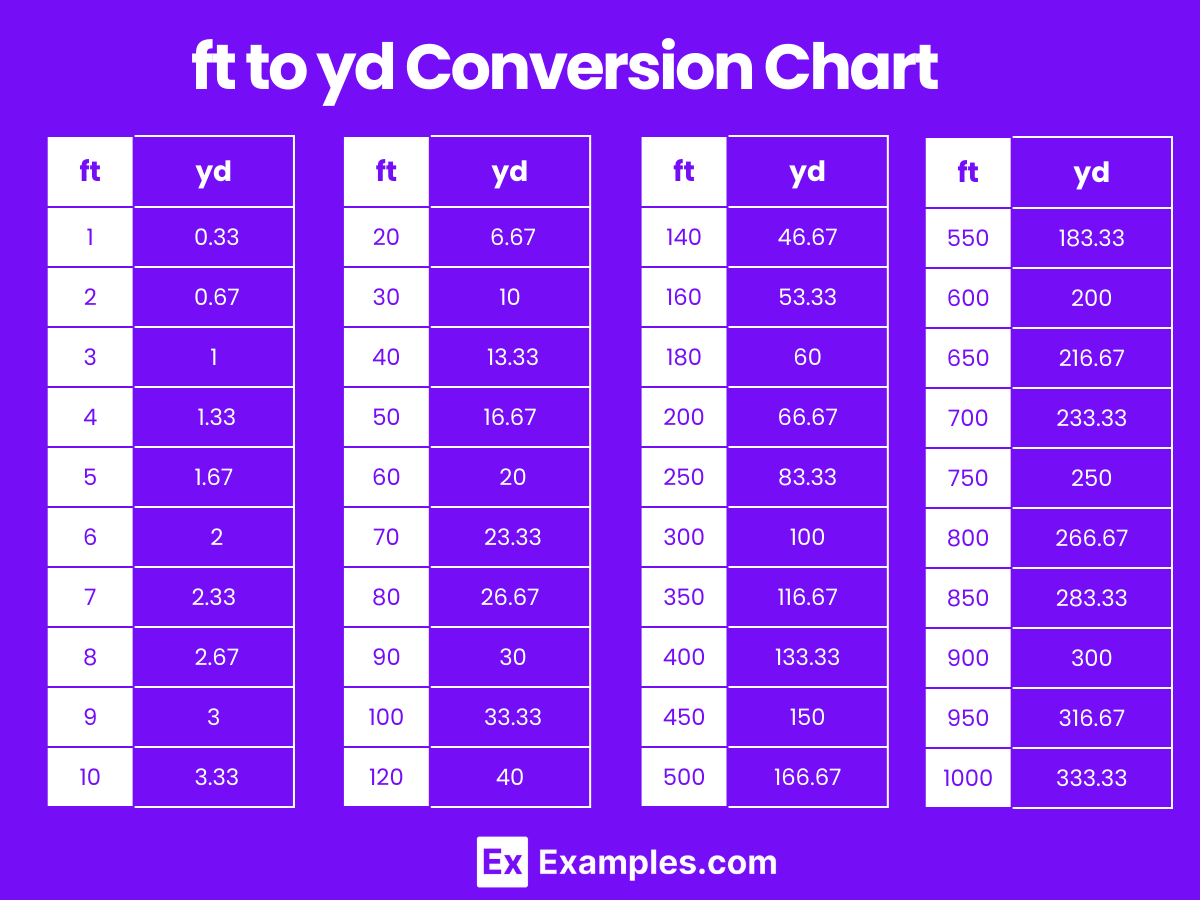Swiftly and accurately convert the length from yard to feet and vice versa at Examples.com. Just input your measurement to receive instant results.
yd to ft
Formula: Length in foot (ft) = Length in yards (yd) × 3
Yard:
Foot:
| Yards | Foot |
|---|---|
| 1 | 3 |
ft to yd
Formula: Length in yards (yd) = Length in foot (ft) ÷ 3
Foot:
Yard :
| Foot | Yards |
|---|---|
| 1 | 0.333333 |

Length Converters to Yard (yd)
| Kilometer to Yard | Meter to Yard | Centimeter to Yard |
| Millimeter to Yard | Micrometer to Yard | Nanometer to Yard |
| Mile to Yard | Feet to Yard | Inch to Yard |
| Nautical Mile to Yard |
Length Converters to Feet (ft)
| Kilometer to Feet | Meter to Feet | Centimeter to Feet |
| Millimeter to Feet | Micrometer to Feet | Nanometer to Feet |
| Mile to Feet | Yard to Feet | Inch to Feet |
| Nautical Mile to Feet |
Conversion Factors
- Yards to Feet: 1 yard = 3 feet
- Feet to Yards: 1 foot = 1/3 yard
How to Convert Yards to Feet:
To convert yards to feet, multiply the number of yards by 3.
Feet=Yards×3
Example:
Convert 3 yards to feet.
Feet=3×3=9 feet
How to Convert Feet to Yards:
To convert feet to yards, divide the number of feet by 3.
Yards=Feet/3
Example:
Convert 9 feet to yards.
Yards=9/3=3 yards
Yards to Feet Conversion Table
| Yards (yd) | Feet (ft) |
|---|---|
| 1 yd | 3 ft |
| 2 yd | 6 ft |
| 3 yd | 9 ft |
| 4 yd | 12 ft |
| 5 yd | 15 ft |
| 6 yd | 18 ft |
| 7 yd | 21 ft |
| 8 yd | 24 ft |
| 9 yd | 27 ft |
| 10 yd | 30 ft |
| 20 yd | 60 ft |
| 30 yd | 90 ft |
| 40 yd | 120 ft |
| 50 yd | 150 ft |
| 60 yd | 180 ft |
| 70 yd | 210 ft |
| 80 yd | 240 ft |
| 90 yd | 270 ft |
| 100 yd | 300 ft |
| 120 yd | 360 ft |
| 140 yd | 420 ft |
| 160 yd | 480 ft |
| 180 yd | 540 ft |
| 200 yd | 600 ft |
| 250 yd | 750 ft |
| 300 yd | 900 ft |
| 350 yd | 1050 ft |
| 400 yd | 1200 ft |
| 450 yd | 1350 ft |
| 500 yd | 1500 ft |
| 550 yd | 1650 ft |
| 600 yd | 1800 ft |
| 650 yd | 1950 ft |
| 700 yd | 2100 ft |
| 750 yd | 2250 ft |
| 800 yd | 2400 ft |
| 850 yd | 2550 ft |
| 900 yd | 2700 ft |
| 950 yd | 2850 ft |
| 1000 yd | 3000 ft |
yd to ft Conversion Chart

Feet to Yards Conversion Table
| Feet (ft) | Yards (yd) |
|---|---|
| 1 ft | 0.33 yd |
| 2 ft | 0.67 yd |
| 3 ft | 1 yd |
| 4 ft | 1.33 yd |
| 5 ft | 1.67 yd |
| 6 ft | 2 yd |
| 7 ft | 2.33 yd |
| 8 ft | 2.67 yd |
| 9 ft | 3 yd |
| 10 ft | 3.33 yd |
| 20 ft | 6.67 yd |
| 30 ft | 10 yd |
| 40 ft | 13.33 yd |
| 50 ft | 16.67 yd |
| 60 ft | 20 yd |
| 70 ft | 23.33 yd |
| 80 ft | 26.67 yd |
| 90 ft | 30 yd |
| 100 ft | 33.33 yd |
ft to yd Conversion Chart

Difference Between Yards to Feet
| Aspect | Yard | Feet |
|---|---|---|
| Basic Definition | A yard is a unit of length in both the imperial and US customary systems. It is equal to 3 feet or 36 inches. | A foot is a unit of length, used primarily in the imperial and US customary measurement systems, equivalent to 12 inches. |
| International Usage | Yards are used less frequently around the world, more common in the U.S., U.K., and former British colonies. | Feet are used globally, especially in the United States for many everyday applications including height measurement. |
| Conversion Factor | 1 yard = 3 feet | 1 foot = 0.333 yards |
| Sporting Events | Often used in American football to measure distances on the field. Each end zone is 10 yards deep. | Commonly used in soccer to measure the penalty area and goal area dimensions. |
| Textiles and Fabrics | Fabric is commonly sold by the yard in countries like the United States. | Smaller textile measurements in craft projects may use feet. |
| Construction and Real Estate | Used in real estate in some countries to describe lot sizes. | Feet are extensively used in construction and real estate to describe building dimensions and room sizes. |
| Nautical Purposes | Not typically used in nautical settings. | Nautical distances are usually measured in nautical mile or feet for smaller measurements. |
| General Public Understanding | Generally considered less intuitive for everyday use by the general public in countries using metric system. | Feet are often seen as more practical for daily use in non-metric countries, possibly due to their shorter length which allows for more precise measurements without using fractions |
1. Solved Examples on Converting Yards to Feet
Example 1: Convert 4 yards to feet.
Feet=Yards×3
4×3=12 feet
Example 2: Convert 7 yards to feet.
Feet=Yards×3
7×3=21 feet
Example 3: Convert 2.5 yards to feet.
Feet=Yards×3
2.5×3=7.5 feet
Example 4: Convert 10 yards to feet.
Feet=Yards×3
10×3=30 feet
Example 5: Convert 0.75 yards to feet.
Feet=Yards×3
0.75×3=2.25 feet
2. Solved Examples on Converting Feet to Yards
Example 1: Convert 15 feet to yards.
Yards=Feet/3
15/3 = 5 yards
Example 2: Convert 6 feet to yards.
Yards=Feet/3
6/3=2 yards
Example 3: Convert 20 feet to yards.
Yards=Feet/3
20/3=6.67 yards
Example 4: Convert 33 feet to yards.
Yards=Feet/3
33/3=11 yards
Example 5: Convert 18 feet to yards.
Yards=Feet/3
18/3=6 yards
Why are yards converted into feet?
Yards are converted into feet for tasks requiring a smaller unit of measurement, such as construction projects, fabric measurement, or when dimensions are required in feet for compatibility with other data.
Is the conversion from yards to feet the same internationally?
Yes, both yards and feet are part of the Imperial system, which is standardized internationally.
Are there any industries that specifically use yards instead of feet?
Yes, industries such as textiles and sports (like football) often use yards to measure fabric lengths and field dimensions, respectively.
How do you teach children the conversion from yards to feet?
Using real-life examples like measuring parts of a playground or using a tape measure can help children understand the relationship between yards and feet.
Why might someone need to convert square yards to square feet?
This conversion might be necessary in fields like real estate or interior design, where room sizes might be given in square yards but decorating materials are sold by square feet.
How can one visually represent the relationship between yards and feet?
Using a ruler or measuring tape that shows both yards and feet, or diagrams that illustrate the units can help visually represent their relationship.
Can yards and feet be converted into metric units?
Yes, yards and feet can both be converted into metric units. One yard is approximately 0.9144 meter, and one foot is about 0.3048 meters.
Why would you measure something in yards instead of feet?
Measuring in yards instead of feet is often more practical for larger distances where using feet could result in unwieldy numbers, simplifying calculations and communication in contexts like sports fields or fabric sales.

